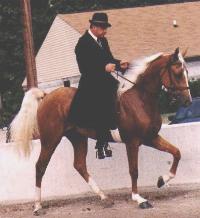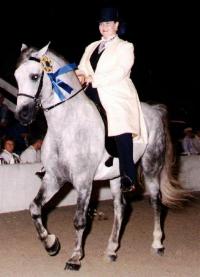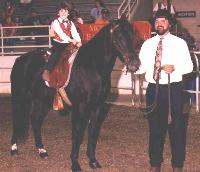|
|
 |
The Mountain
Pleasure Horse |
History Of The
Mountain Pleasure Horse
For more than 160 years, Eastern Kentuckians
have enjoyed their homegrown product, the Mountain Pleasure Horse. Generation
after generation of Kentuckians have stories to tell of their easy gaited, hard
working, good disposition, reliable Mountain Pleasure Horses.
For years called "Mountain
Horses" or "Country Saddle" horses, the Mountain Pleasure Horse
is the old-time gaited breed of horse that existed in Kentucky 160 years ago
and from which selective breeders developed the Tennessee Walking Horses,
American Saddlebred Horses and more recently Rocky Mountain Horses. Long before
these other gaited breeds were in existence, a particular type of horse was
being bred on the steep hillsides to work the fields and "ride the
best". The Mountain Pleasure Horse quietly existed in the mountains of
Eastern Kentucky where the Breeders maintained the old-time horse, by selecting
for their basic criteria-- GAIT and DISPOSITION
General Conformation
RequirementsThe general conformation of
the Mountain Pleasure Horse is described in the bylaws of the Mountain Pleasure
Horse Association as follows:
- The height of the horse will be no less than
58 inches (14.2 hands) at the withers.
- The horse should have medium sized bones, with
medium feet in proportion to the body.
- The horse should have a wide and deep chest.
- The fore and hind legs should be free of
noticeable deformity.
- The shoulders should be sloping, ideally with
an angle of 45 degrees.
- The horse should have bold eyes and well
shaped ears, with a face which is neither dished nor protruding.
- The head should be medium sized, in proportion
to the body, with medium sized jaws.
- The neck should be gracefully arched, medium
in length and set in at an angle to allow a natural carriage with a break at
the poll.
- Any solid body color is acceptable, however
spotted Mountain Pleasure Horses are not encouraged by the association for
breeding or showing.
To be eligible for registration, the horse must
meet registration rules concerning conformation as follows:
- Any body color is acceptable, however, spotted
Mountain Pleasure Horses are not encouraged by the association for breeding or
showing. Standard recognized colors of the Mountain Pleasure Horse include, but
are not limited to, bay, black, chestnut/sorrel, roan, gray cremello, buckskin,
palomino, and chocolate.
- Horses must be at least 14.2 hands (58 inches)
tall at the withers prior to inspection and being permanently registered.
- Horses must demonstrate the recognized gait
under saddle. The recognized gait is defined as follows:
An evenly spaced, four beat lateral gait with moderate forward speed and
extension, without exaggerated knee or hock action. The gait should be smooth,
supple, cadenced and animated with the horse collected and balanced and
exhibiting symmetry in flexion and extension.
- Horses must exhibit good disposition.
- Horses must exhibit a reasonable amount of
"eye appeal".
Mountain Pleasure Horse
Information
 |
Gait
The Mountain Pleasure Horse's distinctive,
easy-riding gait allows the surefooted horse to cover alot of ground with
minimum effort for both horse and rider.
The gait is an evenly spaced, four beat lateral
gait with moderate forward speed and extension, without exaggerated knee and
hock action. The horse moves out with a gait in which one can count four
distinct hoofbeats that produce a cadence of near equal rhythm.
The gait is natural. It is bred into these
horses through generations of proper breeding. No action devices, aids or harsh
training methods are necessary or allowed by the Mountain Pleasure Horse
Association.
|
The Breed of Horse For All
Ages
 |
Disposition
The disposition and trainability of the
Mountain Pleasure Horse may be the most appreciated characteristic for novice
horse owners. They are a very intelligent horse that loves attention. Veteran
trainers of other breeds are amazed at how fast they learn. It is not uncommon
to see 2 and 3 year olds effectively competing with older horses at area horse
shows or on challenging trail rides. Once the Mountain Please Horse has been
trained, they remember their lessons well. Who has the time, today, to ride a
horse every day? The Mountain Pleasure Horse is waiting, with its natural gait
and willing disposition, whether you ride once a week or once a month.
|
The Mountain Pleasure Horse
Association Explains
"What is the Difference?"
Our goal is first to preserve the bloodlines of
the Mountain Pleasure Horse, then to build the population of Mountain Pleasure
Horses. We issue registration papers not to sell these horses, but to certify
they meet the stringent criteria of the Mountain Pleasure Horse Association
(MPHA) and to encourage the breeding of Mountain Pleasure Horses.
Those are our goals and so we do not consider
ourselves to be in "competition" with any other gaited horse breed.
However, some of our horses are double registered with the Rocky Mountain Horse
Association (RMHA), and many are double registered with the Kentucky Mountain
Saddle Horse Association (KMSHA), so naturally, we are asked the difference
between the Mountain Pleasure Horse and these other associations.
Rocky Mountain Difference
Quite simply, the Mountain Pleasure Horse breed existed some 100 years before
the existence of the Rocky Mountain Horse. In fact, Kentucky governor Brereton
Jones, in September of 1994 recognized in his official proclamation:
- "The Horsemen of Eastern Kentucky
developed a type of horse, known as the Mountain Pleasure Horse, to be smooth
of gait, gentle of disposition, willing to work and sure-footed as necessary
for mountain terrain; and
- This Mountain Pleasure Horse has been
carefully and closely bred for over 160 traceable years along the original
Kentucky mountain bloodlines; and
- Blood typing research by the University of
Kentucky has shown the Mountain Pleasure Horse to be the parent stock of
American gaited horse breeds," including the Rocky Mountain Horse and
Tennessee Walking Horse.
On the other hand, some 40 to 45 years ago, Sam
Tuttle tapped into the Mountain Horse Heritage, crossing the native Mountain
Pleasure stock with Tobe, a stallion carrying an unusual chocolate color, and
his descendants, spawning (eventually) the Rocky Mountain Horse Association
breed registry.
The key difference between the two registries
is genetic foundation. Fewer than 17 percent of the foundation horses of the
Mountain Pleasure Horse Association carry any trace of the "Tobe"
bloodline.
In the MHPA, color is not a criteria of
quality. In the RMHA, the chocolate color is generally preferred. Besides the
chocolate color there are, to those who study closely, various physical
characteristics and slight variations in gait among horses descended from Tobe
bloodlines that generally are not present in the Mountain Pleasure Horses.
The MPHA registration books are now closed and
only offspring of a registered stallion and a registered mare can be submitted
for registration. We have no provisions for "grade mares." The MPHA
registration process requires that all horses submitted for permanent
registration be videotaped demonstrating gait and the Board of Directors of the
MPHA must approve each horse. The MPHA requires that all its horses be blood
typed by the University of Kentucky for absolute identification of parentage
before papers are issued.
Generally speaking, our horses tend to be a bit
larger (taller), longer bodied and cover more ground with their gait than the
horses from the Tobe/Tuttle bloodlines.
We are proud of the Mountain Pleasure Horse
genetic heritage that helped produce the horses of the the Tobe/Tuttle
bloodlines. We realize that some people may prefer the results and color of the
Tobe/Tuttle influenced horse. But for those who want the old-fashioned smooth
ride and wonderful disposition of over 150 years of Kentucky heritage, backed
by the integrity of blood typing and stringent scrutiny by the MPHA breed
registry, we offer the Mountain Pleasure Horse.
Kentucky Mountain Saddle Horse
Difference
Horses registered in the Kentucky Mountain Saddle Horse Association are often
referred to as Kentucky Mountain Saddle Horses. Several gaited breeds of horses
are included in the Kentucky Mountain Saddle Horse Association's registry, the
Mountain Pleasure Horse being one of them. Whereas, the Mountain Pleasure Horse
and the Rocky Mountain Horse are "breeds" of horses, the Kentucky
Mountain Saddle Horse normally refers to the Kentucky Mountain Saddle Horse
Association registry. As mentioned at the top of this page, many horses
registered with the Mountain Pleasure Horse Association are also doubled
registered with the Kentucky Mountain Saddle Horse Association.
 |
The information and photographs
in this article are kindly provided by the Mountain Pleasure Horse Association.
For further information on this breed, please
click
here. |
|


